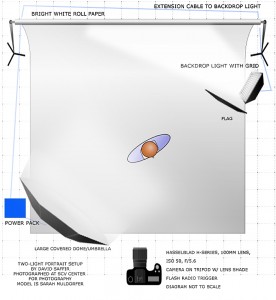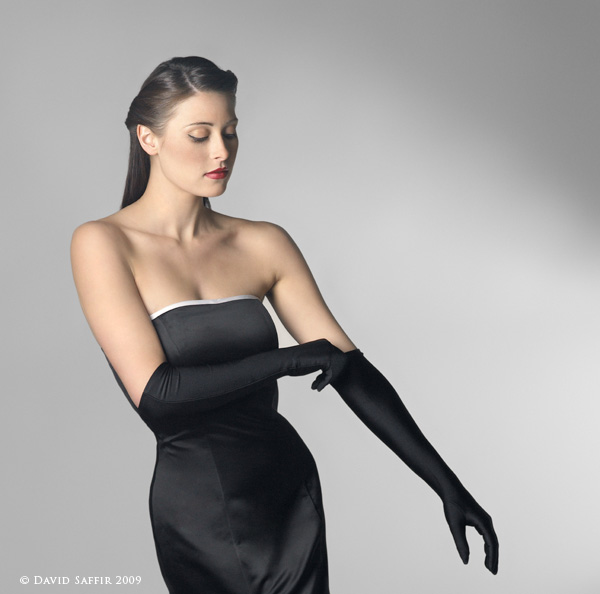As winter is truly upon us, one must remember that when we bring a digital camera from cold weather into a warm house, car or hotel this can cause problems. When you bring a cold camera indoors, there is the possibility of condensation forming. One way to help that, is to wrap your camera gear in a towel, and let the equipment come up to room temperature. The towel will absorb the moisture, and thus assisting in the reduction of possible condensation. There are several different ways or schools of thought regarding how to prevent condensation, but find the method that works best for you and your situation.
Archive for Weekly Tips – Page 4
Today we are pleased to post a guest blog entry by instructor David Saffir on Two-Light Portrait Photography.
Studio lighting can be quite simple, or complex. Beginner or seasoned pro, lighting can be a matter of personal style, equipment on hand, time constraints, or other factors.
I recently photographed Sarah Muldorfer, a model from our area at the SCV Center for Photography. We had started out with a multi-light, high-key setup. Once that was completed, I wanted to switch to a simpler look that emphasized her elegant dress, long hair, and long limbs. Her position on the set is about 6-8 feet in front of the backdrop.
Look at the lighting diagram. There is one primary light, a large umbrella/soft box located camera left, with its center approximately the same level, or a bit higher, than the lens axis. The umbrella is covered with a diffuser.

The second light is also a strobe, set up with small reflector and a barn door. It was used to create a “spotlight” effect on the white background. The light is aimed nearly parallel to the background, and was set to low intensity relative to the main light to create the effect.
Normally I place a flag – such as a piece of foamcore – between a light and the camera to keep the image clean. Also, shooting an image like this with limited lighting pretty much requires that you eliminate ambient lighting – any source can cause issues – including an open door or window, other studio lights, etc.
I often mount the camera on a Gitzo tripod w/ ball head during a shoot. This is a rock-solid setup that works well during shoots where camera position changes fairly frequently. However, Sarah was experimenting with some different poses, and I took the shot hand held, almost as a candid. Exposure was f/8 @ 1/100, ISO 50, 100mm lens (medium format). If that shutter speed seems slow to you, remember that the strobes are firing at a speed of at least 1/1000!
Exposure is very important in this type of shot. If overexposed, detail in the model’s fair skin would be lost. If underexposed, the shadow/highlight transitions, particularly on her skin, would at best be noisy and at worst show a mix of color aliasing and artifacts. I used a hand-held meter to measure exposure. (note: always point the meter into the lens of the camera, not the light. Meter position is usually just under the chin of the subject.) Underexposure would also reduce, or eliminate details in her black dress.
Last, her pose turns most of her body toward the light. The umbrella-diffuser combination gives a wonderfully soft light, which still brings up the details. Her nose does not “break the line” of her cheek, and since she was moving when the shot was taken she looks relaxed and natural. I think this was the shot of the day, and she was very please with it.

For more on Two Light Portrait Lighting, join us on Thursday, January 21st for our Classic Two Light Portrait workshop from 6:30pm to 9:30pm. Call for enrollment information as class size is limited.
Did you know you can sort your photos in Lightroom by Edit Time? In the Library Module there is a very useful sort option called Edit Time. Sorting the grid view by Edit Time will display the thumbnails with the most recent ones at the top of the grid.
This is an easy way to select all of the photos that have had any form of editing applied. Note that adding keywords counts as editing.
For more information, sign-up for our Lightroom workshop on January 19, 2010 from 6:30pm to 9:30pm.
You hear a lot about the power of Adobe Camera RAW (ACR), but did you know you don’t have to shoot RAW to you use it? You can also open JPEG and TIFF files. Simply open Adobe Bridge, select the image you want to open in Adobe Camera RAW, then select “Open in Camera RAW…” from the file menu. (You can also press Ctrl-R in Windows or Cmd-R on a Mac.) You get all the non-destructive editing power of ACR, on your non-RAW images!
For more Photoshop ideas, sign up for our Photoshop 101 workshop series with David Green starting on Wednesday, February 13, 2010.
If you use your off-camera flash a lot your going to go through batteries, so try using nickel-metal hydride (NiMH) rechargeable batteries. They recycle faster than alkaline batteries and you can recharge them quickly.
For more Flash tips and learning, sign up for our “Basics of Camera Flash” with Ron Brewer on Thursday, January 7th from 6:30pm to 9:30pm.
Upcoming Workshops
One-on-One Workshops by appointment only.
Featured Services
One-on-one Workshops
Too busy to schedule a class? Do you learn better one-on-one? Do you have a lot of specific questions and don't want to disrupt a classroom full of students? Then one-on-one training may be for you. Learn Photoshop, general photography and DSLR skills, composition, or flash and strobe techniques in individual workshops, custom-tailored to your needs. Available at the Center, or on-site at your corporate location. Prices start at $75/hour.
PHOTOGRAPHY SERVICES:
We offer a variety of Photographic Services including:
* Studio Portraits
* Weddings
* Special Events
* Senior Portraits
* Head Shots
* Family Location Portraits
* Product Photography
To see our Wedding and Event Photography, please check our website Mel & Company Photography for additional details.
Sign-up for email updates
Contact Us
We are located in Santa Clarita, CA
(661)904-2092
info@scvphotocenter.com
Current Newsletter
Were heading into the dog days of summer and it seems everyone is either getting ready to head out on vacation, or like me, just returning from a photography trip. I was catching up on more than 1200 emails and one in particular caught my eye, a short article talking about 5 tips to shake up your travel photography from Jim Maher. Below is the short version of that article that we hope you enjoy and helps spur some great images in the very near future:
Forget the stock photos and focus on daily life: Sometimes when we are in a beautiful place all we can think about is taking photos of the beautiful architecture, the monuments and the wonders that we travelled to see. But these things are not necessarily what gives a place its essence and its soul. Stop and think about how you feel. What is creating that feeling?
Combine the old with the new: We all want to photograph another time period. So try and seek out moments that combine the old with the new - that pay homage to the past but update it with a modern twist.
Turn your camera away from the sunset: Sunsets are beautiful, but can be cheesy. Over the course of a couple of hours, the light from a sunset will constantly change colors. Set up your tripod, relax, and take identical shots of your surroundings with the different color pallets. Frame them side by side on your wall, and they will look stunning.
Combine a simple detail shot with a great story: Shooting one single frame that says everything is a very powerful image. Finding that image may not be easy, but when you do, you will know it!
Capture the locals: It is the locals both people and animals that give most destinations their true feelings, so go out and capture them!
If a one on one workshop is more your style, we can customize one just for you. Just give us a call. And remember, SCV Center for Photography workshops make great gifts.